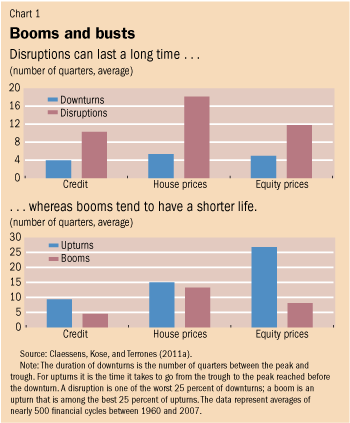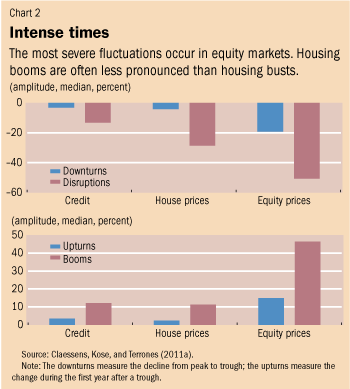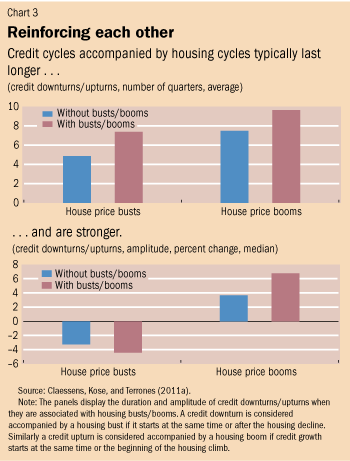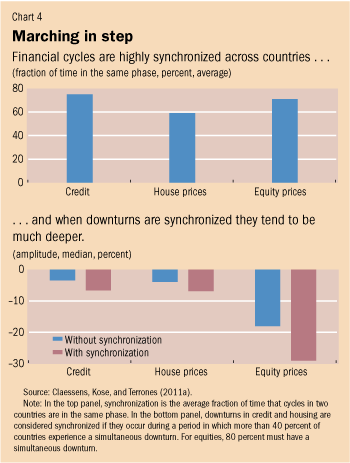Gyrations in Financial Markets
Finance & Development, March 2011, Vol. 48, No. 1
Stijn Claessens, M. Ayhan Kose, and Marco E. Terrones
Financial cycles tend to be long and deep and often interact in ways that can cause booms or busts
ECONOMIC developments over the past two decades vividly show that gyrations in financial markets have greatly influenced real activity around the world. Following the largest housing bubble in its modern history, Japan experienced a massive asset market crash in the early 1990s, which marked the start of its “Lost Decade.” After prolonged credit booms, many emerging economies in Asia faced deep financial crises in the second half of the 1990s. The equity market booms of the late 1990s in a number of advanced economies ended with simultaneous busts and recessions.
The recent global financial crisis was similar to the earlier episodes. However, the so-called Great Recession was truly seismic, as severe credit crunches and asset price busts led to the deepest global recession since the Great Depression of the 1930s.
The recent crisis has not only been a painful reminder of the importance of financial cycles, but it has also exposed our limited understanding of these episodes. Previous research has been based mostly on historical narratives, rather than a systematic analysis of financial cycles. Consequently, many questions have been left unanswered: What are the main features of cycles in financial markets? How synchronized are they? And what happens when cycles in different financial markets coincide?
To answer these questions, we applied the traditional methods of business cycle analysis to a comprehensive database of financial cycles in credit, housing, and equity markets (Claessens, Kose, and Terrones, 2011a). Our study reveals a number of facts about financial cycles. First, financial cycles can be protracted and costly episodes. Second, they can feed off each other and worsen, becoming financial crises. Third, they tend to have a significant global component, as they are highly synchronized across countries. Finally, when they take place in tandem in many countries, they often lead to more costly outcomes. These findings, combined with the results of recent research, have important implications for the design of macroeconomic and financial sector policies.
Identifying financial cycles
It is useful to draw some parallels between the phases of cyclical fluctuations in the financial markets we identify and the fluctuations in output associated with business cycles. A complete business cycle has two phases, the recession phase (from peak to trough) and the expansion phase (from trough to the next peak). In addition to these two phases, recoveries from recessions have also been widely studied. The recovery phase is the early part of the expansion phase and is usually defined as the time it takes output to return from its low point to the level it reached just before the decline began.
We use a similar approach to defining a financial cycle. We call the recovery phase of a financial cycle the upturn and the contraction phase the downturn. For the recovery phase, we consider both the time it took to return to the previous peak (say, the high point of housing prices) and how much the financial variable increased within the first year after its trough. We exclude the rest of the expansion phase, which is typically much longer and can be affected by many structural factors (such as the level of financial sector development and institutions).
When studying business cycles, it is clear what variable should be used: an aggregate measure of economic activity such as gross domestic product (GDP). But it is not so clear when analyzing financial cycles, as it is possible to consider many variables. Given that they constitute the core of financial intermediation—the process that matches up savers with borrowers—we concentrate on cycles in three distinct but interdependent market segments: credit, housing, and equities.
Specifically, we focus on credit volume, house prices, and equity prices for 21 advanced economies—members of the Organization for Economic Cooperation and Development—between 1960 and 2007. We exclude from our analysis the years following the recent crisis because a number of financial cycle episodes associated with the crisis are still ongoing. Our credit volume corresponds to aggregate claims on the private sector by deposit-taking banks; house price series refer to various measures of indices of house or land prices, depending on the source country; and equity prices are share price indices weighted with the market value of outstanding shares. We use quarterly data, seasonally adjusted whenever necessary, and in constant (that is, inflation-adjusted) prices.
Booms, busts, and crunches
We also examine the more intense forms of financial cycles—disruptions and booms—because large movements in financial variables are often associated with highly volatile fluctuations in economic activity. To identify these, we rank the changes in each variable during downturns and upturns. We then classify an episode as a financial disruption if the change in the variable—say, equity prices—during the downturn falls into the bottom quartile of all changes. We call these disruptions either crunches or busts, depending on the variable (that is, credit crunch; house or equity price bust). We classify a movement as a boom if the change in the variable during the upturn falls into the top quartile—that is, we have credit, house, and equity price booms.
There were nearly 500 episodes of financial cycles between the first quarter of 1960 and the final quarter of 2007 across the 23 countries and three variables. We identify 114 downturns in credit, 114 in house prices (house price data begin in 1970 or later for most countries), and 245 in equity prices. Correspondingly, the sample includes 115 upturns in credit, 114 in house prices, and 251 in equity prices. House price cycles are comparable in number to business cycles over this period, while equity cycles are more frequent because of their highly volatile nature. One-fourth of these episodes are disruptions (crunches or busts) or booms.
Long and deep

Financial disruptions are often much longer than normal downturns (see Chart 1). The average duration of disruptions ranges between 10 and 18 quarters, with house price busts lasting the longest. House price busts, at 18 quarters or so, last, on average, almost four times longer than garden-variety housing downturns. In contrast, booms in financial markets tend to be shorter than standard upturns. Credit market booms are the shortest, about 4½ quarters, compared with the average duration of other credit upturns of about 9 quarters, while housing booms are often the longest. A boom in housing lasts about 13 quarters.

Financial cycles tend to be intense episodes as measured by their amplitude—that is, the decline in housing prices, equity prices, or credit volume from peak to trough during downturns and the change in each financial variable during the first four quarters of an upturn (see Chart 2). Credit crunches and house price busts are much more dramatic than other credit and house price downturns. Credit crunches are about four times deeper than the average credit downturn, while house price busts are seven times bigger than the average house price downturn. Equity busts are about twice as large. But in absolute terms, the most severe fluctuations take place in equity markets—where prices during a typical boom register about a 45 percent increase and a slightly larger decline during a bust episode. In the case of housing markets, swings are typically more asymmetric across the two phases of the cycle: an increase of 11 percent during booms and a decline of 29 percent during busts.
Reinforcing each other
What is at play when domestic financial markets are in roughly the same phase of the cycle? Is it more than coincidence? To answer this question, we employ a simple timing rule. Specifically, we consider a downturn in one financial variable to be associated with a disruption in another if the downturn starts at the same time or shortly after the disruption in the other variable. We employ a similar approach with upturns.

An association between the movements in two variables, of course, does not necessarily indicate that one caused the other. However, our results show the presence of strong interactions—between credit and housing markets, for example. Credit downturns that overlap with house price busts are longer and deeper than other credit downturns (see Chart 3). Similarly, when credit upturns coincide with episodes of housing booms, they tend to be longer and stronger. For example, a credit upturn becomes 25 percent longer and 40 percent larger when it coincides with a housing boom. This finding is suggestive of the important role that mortgage lending plays in many economies.
Credit cycles appear to behave differently when they coincide with cycles in equity markets. Although credit downturns accompanied by equity price downturns are not significantly longer, they tend to be more severe than others. Interestingly, equity cycles seem to be little affected when they are associated with cycles in other financial markets, probably because of the idiosyncratic nature of factors driving fluctuations in equity markets.
The strong linkages between the credit and asset price cycles we document are consistent with the mechanisms described in various economic models. For example, models featuring the so-called financial accelerator mechanism emphasize that there are feedback effects between financial markets and the real economy and among various financial sector segments. These models suggest, for example, that a decline in net worth, induced perhaps by a fall in asset prices, leads borrowers to reduce their credit demand, spending, and investment. This in turn causes the output of goods and services to shrink further in what can become a self-reinforcing cycle of falling output and falling asset prices.
Models that operate on the supply side of finance also suggest strong linkages among various segments of financial markets. They focus on the balance sheets of financial intermediaries (such as banks, which take in deposits and make loans) as an indication of their ability to provide credit and other external financing. They stress that conditions in credit markets can influence asset prices (and real activity) and vice versa. For example, when banks increase their leverage by accumulating debt, they tend to extend a larger volume of credit, which in turn can lead to an increase in asset prices. Conversely, a decrease in leverage can prompt a decline in asset prices.
Highly synchronized across countries
Financial cycles also often occur simultaneously across countries—suggesting that the global nature of the recent crisis is not unusual. We examine the degree of synchronization of cycles using a so-called concordance index, which measures the percentage of time two countries are in the same phase of a respective financial cycle.

Credit and equity cycles display the highest degree of synchronization across countries (see Chart 4, top panel). These cycles tend to be in the same phase about 75 percent of the time. Although houses are nontradable assets, the extent of synchronization of housing cycles across countries is still high—about 60 percent. This finding partly reflects the important role played by global factors—including the world interest rate, the global business cycle, and commodity prices—in explaining house price movements around the world. The degree of synchronization in the case of housing and equity markets has actually increased over time, probably due to the expansion of cross-border trade and financial flows.
And when financial cycles are highly synchronized across countries, they tend to be more severe (see Chart 4, lower panel). In the case of highly synchronized equity downturns, for example, prices drop by about 30 percent, compared with some 18 percent for other downturns. Similarly, synchronized financial upturns are often more buoyant.
Rethinking cycles and policies
The main lessons from our extensive study of financial cycles are sobering. First, financial cycles can be long and deep, especially those in housing and equity markets. Second, financial cycles accentuate each other and become magnified during coincident downturns in credit and housing markets. Third, they are highly synchronized across countries, and the extent of such synchronization has been increasing over time, possibly because of the forces of globalization. Finally, globally synchronized downturns tend to be associated with more costly episodes, especially in credit and equity cycles.
Economists have long studied the interactions between different types of cycles, and that research has had important policy implications. For example, the extensive study of the linkages between business cycles and inflation cycles has led economists to warn of the risk of higher inflation if monetary policy is lax and the economy is producing more goods and services than its potential. Conversely, they warn of deflation if monetary policy is tight and the level of economic activity is below its potential.
The recent global financial crisis has led to an extensive debate about the formulation of monetary and financial sector policies. This debate has emphasized not just the link between inflation and business cycles, but also the impact of cycles in financial markets on business cycles.
Combined with the results from earlier research (see “When Crises Collide,” F&D, December 2008), our findings on financial cycles provide useful input into these ongoing policy debates. In light of the multidimensional interactions between financial and business cycles, the observations we document suggest that close monitoring of cycles in financial markets should be an integral part of macroeconomic surveillance and policy design (Claessens, Kose, Terrones, 2011b). For example, in addition to the linkages between the inflation and business cycles, policymakers might want to take into account the state of cycles in financial markets when they formulate monetary policies.
Our analysis also suggests that it is important to account for the interactions among financial cycles when designing regulatory policies to ensure the health of the overall system. For example, if both credit and housing prices rapidly are growing it might be necessary to employ stricter rules and lending standards for mortgage lending as well as larger countercyclical buffers to moderate fluctuations in banks’ capital positions, because cycles in credit and housing markets tend to enhance each other. More generally, the design of macroprudential rules must account for the linkages among cycles in different financial market segments.
Because financial cycles are often synchronized internationally, it is imperative to consider the global aspects of financial regulation and surveillance policies. However, such global policies might need to be adaptive and flexible, because financial systems operate differently in different countries. ■
Stijn Claessens is an Assistant Director, M. Ayhan Kose is an Assistant to the Director, and Marco E. Terrones is a Deputy Division Chief, all in the IMF’s Research Department.
References:
Claessens, Stijn, M. Ayhan Kose, and Marco E. Terrones, 2011a, “Financial Cycles: What? How? When?” forthcoming in NBER International Seminar in Macroeconomics 2010, ed. by Richard Clarida and Francesco Giavazzi.
———, 2011b, “How Do Business and Financial Cycles Interact?” forthcoming IMF Working Paper (Washington: International Monetary Fund).


